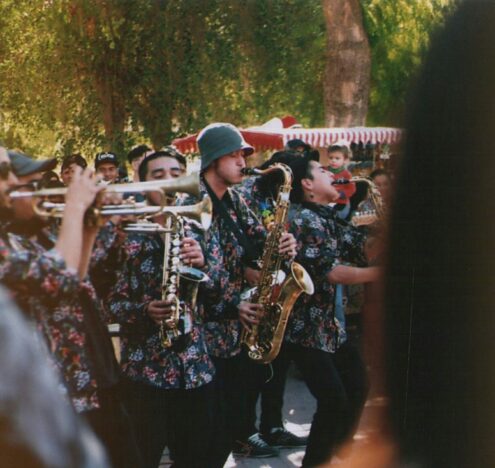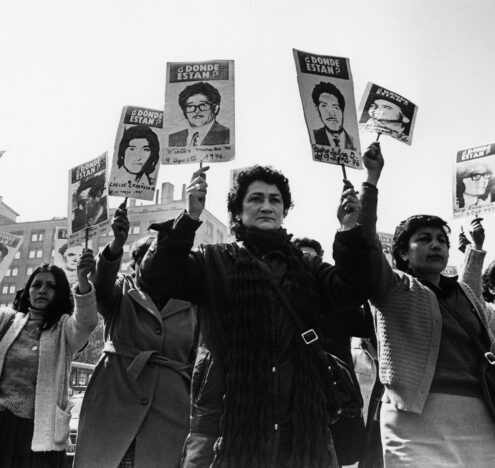This year, the Grammys awarded the first “Best Song for Social Change” to Shervin Hajipour, a now-imprisoned Iranian singer-songwriter. His song, “Baraye” (“For”) — a minimal, lilting, grief-filled power ballad in Farsi filmed on a phone in Hajipour’s bedroom — was reshared over 40 million times in 2 days, covered by singers all over the world, and became the de facto anthem of protests following Mahsa Amini’s death.
Just a few weeks prior, “Naatu Naatu” (“Countryside” or “Local”) from the Telugu-language Indian blockbuster RRR won “Best Original Song” at the Golden Globes. The fast-paced, percussive dance number features two Indian action heroes outdancing British colonizers. With an intensely catchy beat appropriated from Indigenous South Indian drumming traditions, an uncountable number of backup dancers, and a multimillion-dollar budget, “Naatu Naatu” became the most-watched Telugu song on YouTube while its choreography became a popular TikTok challenge.
These two songs could not be more different in aesthetics or production, yet they share many similarities as viral sensations finding currency on internationally recognized stages. Positively, they challenge the anglocentrism of the American music scene (with “Naatu Naatu” further challenging the linguistic dominance of Hindi in India). Given the increasing visibility, affluence, and social capital of Indian and Iranian diaspora communities, these recognitions affirm a growing collective desire to be celebrated in the American cultural milieu.
SONGS FOR THE HEGEMONIC STASIS
But it is the political contexts they were conceived and are enmeshed in that differ most significantly: “Baraye” is directed in resistance to the government of the Islamic Republic of Iran, a government whose instability the United States is famously invested in (and has historically orchestrated). Meanwhile, “Naatu Naatu” is a jingoist show tune drumming up unconditional support for the increasingly fascist government of India that the United States has been courting for decades. And though the umbrella narratives of “foreignness” or the vague-but-all-encompassing genre title of “World Music” may chuck both songs into the same bucket, the simple facts of their original intention mean that we cannot celebrate them in the same way.
In the geopolitical realities behind the receptions to these songs, the American hegemon self-congratulates for its compassionate cosmopolitanism, hides inconveniently cruel allies, and justifies sanctimonious intervention.
Yet, that is exactly what we in the United States are doing — and with fanfare. “Naatu Naatu” is set to be performed at the Oscars with nary any outcry for the Indian government’s sanction of violence in Kashmir and against non-Hindu religious minorities, caste-oppressed communities, and Indigenous populations. Meanwhile, the Grammys staged the grotesque irony of Jill Biden celebrating Hajipour as his lyrics “For Afghan children” — who her husband has summarily abandoned to the Taliban — scrolled behind her. In the geopolitical realities behind the receptions to these songs, the American hegemon self-congratulates for its compassionate cosmopolitanism, hides inconveniently cruel allies, and justifies sanctimonious intervention. And as we in the diaspora both seek out and process recognition, strategies to ensure our allegiance become writ as narratives of integration and acceptance.
While Harry Styles’ “Best Album” win and speech have inspired outrage and reflection on representation in the music industry, the juxtaposing cases of “Baraye” and “Naatu Naatu” invite discussion on who decides and is served by its chimeric diversity. These two songs — for aesthetic as much as political reasons — have indisputably proven their universal popularity in the globalizing musical zeitgeist. Though awards from a US cultural institution may seem additional cause to celebrate, a critical eye to the optics of recognition uncovers broader geopolitical aims vis-à-vis international originator and diaspora communities.
This is not to demonize the appreciation of these songs, detract from the well-deserved (and much-needed!) recognition of non-American or Western European music or, especially in the case of Hajipour, demobilize in the interests of at-risk artists. This is to question whether “representation” via the playlist of the US cultural empire is worth being the justification for its extractive saviorism. Above all, this is to insist that when extricated from capitalism, nationalist egos, and geopolitical agendas, beauty still abounds.
It is on all of us as audiences and artists in our own right to hasten that extrication. Between two songs, we are but a few clicks away from self-educating, exploring, and patronizing vast networks of at-risk or marginalized musicians. And with collective intention — not selective, institutional representation — the pursuits of justice and pleasure become mutually reinforcing through the musics we are learning to love.





















